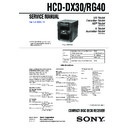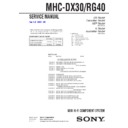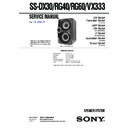Sony HCD-RG40 / MHC-DX30 / MHC-RG40 Service Manual ▷ View online
2
HCD-DX30/RG40
Tape deck section
Recording system
4-track 2-channel stereo
Frequency response
40 – 13,000 Hz (
±
3 dB),
using Sony TYPE I
cassette
cassette
Tuner section
FM stereo, FM/AM superheterodyne tuner
FM tuner section
Tuning range 87.5 – 108.0 MHz
Antenna
Antenna
FM lead antenna
Antenna terminals
75 ohm unbalanced
Intermediate frequency
10.7 MHz
AM tuner section
Tuning range
US, Canadian, Mexican, Argentina models:
US, Canadian, Mexican, Argentina models:
530 – 1,710 kHz (with the
interval set at 10 kHz)
531 – 1,710 kHz (with the
interval set at 9 kHz)
interval set at 10 kHz)
531 – 1,710 kHz (with the
interval set at 9 kHz)
European and Middle Eastern models:
531 – 1,602 kHz (with the
interval set at 9 kHz)
interval set at 9 kHz)
Other models:
531 – 1,602 kHz (with the
interval set at 9 kHz)
530 – 1,710 kHz (with the
interval set at 10 kHz)
interval set at 9 kHz)
530 – 1,710 kHz (with the
interval set at 10 kHz)
Antenna
AM loop antenna
Antenna terminals
External antenna terminal
Intermediate frequency
450 kHz
General
Power requirements
US, Canadian models:
US, Canadian models:
120 V AC, 60 Hz
European models:
230 V AC, 50/60 Hz
Australian models:
230 – 240 V AC,
50/60 Hz
50/60 Hz
Mexican models:
120 V AC, 50/60 Hz
Other models:
120 V, 220 V or
230 – 240 V AC,
50/60 Hz
Adjustable with voltage
selector
230 – 240 V AC,
50/60 Hz
Adjustable with voltage
selector
Power consumption
USA models:
HCD-RG40:
USA models:
HCD-RG40:
140 watts
Canadian models:
HCD-RG40:
HCD-RG40:
140 watts
European models:
HCD-RG40:
HCD-RG40:
140 watts
HCD-RG40:
0.5 watts (at the Power
Saving Mode)
Saving Mode)
Other models:
HCD-DX30:
HCD-DX30:
175 watts
Dimensions (w/h/d)
Approx. 280
×
325
×
421 mm
Mass
North American models:
HCD-RG40:
North American models:
HCD-RG40:
Approx. 9.0 kg
European models:
HCD-RG40:
HCD-RG40:
Approx. 9.0 kg
Other models:
HCD-DX30:
HCD-DX30:
Approx. 10.0 kg
Design and specifications are subject to change
without notice.
without notice.
SAFETY-RELATED COMPONENT WARNING!!
COMPONENTS IDENTIFIED BY MARK
0
OR DOTTED LINE WITH
MARK
0
ON THE SCHEMATIC DIAGRAMS AND IN THE PARTS
LIST ARE CRITICAL TO SAFE OPERATION. REPLACE THESE
COMPONENTS WITH SONY PARTS WHOSE PART NUMBERS
APPEAR AS SHOWN IN THIS MANUAL OR IN SUPPLEMENTS
PUBLISHED BY SONY.
COMPONENTS WITH SONY PARTS WHOSE PART NUMBERS
APPEAR AS SHOWN IN THIS MANUAL OR IN SUPPLEMENTS
PUBLISHED BY SONY.
ATTENTION AU COMPOSANT AYANT RAPPORT
À LA SÉCURITÉ!
LES COMPOSANTS IDENTIFÉS PAR UNE MARQUE
0
SUR LES
DIAGRAMMES SCHÉMATIQUES ET LA LISTE DES PIÈCES SONT
CRITIQUES POUR LA SÉCURITÉ DE FONCTIONNEMENT. NE
REMPLACER CES COMPOSANTS QUE PAR DES PIÈSES SONY
DONT LES NUMÉROS SONT DONNÉS DANS CE MANUEL OU
DANS LES SUPPÉMENTS PUBLIÉS PAR SONY.
CRITIQUES POUR LA SÉCURITÉ DE FONCTIONNEMENT. NE
REMPLACER CES COMPOSANTS QUE PAR DES PIÈSES SONY
DONT LES NUMÉROS SONT DONNÉS DANS CE MANUEL OU
DANS LES SUPPÉMENTS PUBLIÉS PAR SONY.
To Exposed Metal
Parts on Set
0.15
µ
F
1.5 k
Ω
AC
Voltmeter
(0.75 V)
Voltmeter
(0.75 V)
Earth Ground
Fig. A. Using an AC voltmeter to check AC leakage.
After correcting the original service problem, perform the
following safety checks before releasing the set to the customer:
Check the antenna terminals, metal trim, “metallized” knobs, screws,
and all other exposed metal parts for AC leakage. Check leakage as
described below.
following safety checks before releasing the set to the customer:
Check the antenna terminals, metal trim, “metallized” knobs, screws,
and all other exposed metal parts for AC leakage. Check leakage as
described below.
LEAKAGE
The AC leakage from any exposed metal part to earth ground and
from all exposed metal parts to any exposed metal part having a
return to chassis, must not exceed 0.5 mA (500 microamperes).
Leakage current can be measured by any one of three methods.
from all exposed metal parts to any exposed metal part having a
return to chassis, must not exceed 0.5 mA (500 microamperes).
Leakage current can be measured by any one of three methods.
1.
A commercial leakage tester, such as the Simpson 229 or RCA
WT-540A. Follow the manufacturers’ instructions to use these
instruments.
WT-540A. Follow the manufacturers’ instructions to use these
instruments.
2.
A battery-operated AC milliammeter. The Data Precision 245
digital multimeter is suitable for this job.
digital multimeter is suitable for this job.
3.
Measuring the voltage drop across a resistor by means of a
VOM or battery-operated AC voltmeter. The “limit” indication
is 0.75 V, so analog meters must have an accurate low-voltage
scale. The Simpson 250 and Sanwa SH-63Trd are examples of
a passive VOM that is suitable. Nearly all battery operated
digital multimeters that have a 2V AC range are suitable. (See
Fig. A)
VOM or battery-operated AC voltmeter. The “limit” indication
is 0.75 V, so analog meters must have an accurate low-voltage
scale. The Simpson 250 and Sanwa SH-63Trd are examples of
a passive VOM that is suitable. Nearly all battery operated
digital multimeters that have a 2V AC range are suitable. (See
Fig. A)
SAFETY CHECK-OUT
3
HCD-DX30/RG40
This appliance is classified as a CLASS 1 LASER product. The
CLASS 1 LASER PRODUCT MARKING is located on the rear
exterior.
CLASS 1 LASER PRODUCT MARKING is located on the rear
exterior.
Laser component in this product is capable
of emitting radiation exceeding the limit for
Class 1.
of emitting radiation exceeding the limit for
Class 1.
CAUTION
Use of controls or adjustments or performance of procedures
other than those specified herein may result in hazardous radiation
exposure.
other than those specified herein may result in hazardous radiation
exposure.
Notes on chip component replacement
• Never reuse a disconnected chip component.
• Notice that the minus side of a tantalum capacitor may be
• Notice that the minus side of a tantalum capacitor may be
damaged by heat.
Flexible Circuit Board Repairing
• Keep the temperature of soldering iron around 270˚C
during repairing.
• Do not touch the soldering iron on the same conductor of the
circuit board (within 3 times).
• Be careful not to apply force on the conductor when soldering
or unsoldering.
NOTES ON HANDLING THE OPTICAL PICK-UP
BLOCK OR BASE UNIT
BLOCK OR BASE UNIT
The laser diode in the optical pick-up block may suffer electrostatic
break-down because of the potential difference generated by the
charged electrostatic load, etc. on clothing and the human body.
During repair, pay attention to electrostatic break-down and also
use the procedure in the printed matter which is included in the
repair parts.
The flexible board is easily damaged and should be handled with
care.
break-down because of the potential difference generated by the
charged electrostatic load, etc. on clothing and the human body.
During repair, pay attention to electrostatic break-down and also
use the procedure in the printed matter which is included in the
repair parts.
The flexible board is easily damaged and should be handled with
care.
NOTES ON LASER DIODE EMISSION CHECK
The laser beam on this model is concentrated so as to be focused on
the disc reflective surface by the objective lens in the optical pick-
up block. Therefore, when checking the laser diode emission,
observe from more than 30 cm away from the objective lens.
the disc reflective surface by the objective lens in the optical pick-
up block. Therefore, when checking the laser diode emission,
observe from more than 30 cm away from the objective lens.
TABLE OF CONTENTS
MODEL IDENTIFICATION
— BACK PANEL —
MODEL
US, CND models
AEP model
AR, E, E51, SP models
AUS, KR, MX, TH models
PARTS No.
4-234-032-6
s
4-234-032-5
s
4-234-091-1
s
4-234-091-7
s
• Abbreviation
CND : Canadian model
AUS
AUS
: Australian model
SP
: Singapore model
TH
: Thai model
PARTS No.
1. SERVICE NOTE
······························································· 4
2. GENERAL
·········································································· 5
3. DISASSEMBLY
································································ 7
4. TEST MODE
···································································· 12
5. ELECTRICAL ADJUSTMENTS
······························· 16
6. DIAGRAMS
······································································ 19
6-1. Circuit Board Location ················································ 20
6-2. Block Diagrams Tuner/CD Section ···························· 21
6-2. Block Diagrams Tuner/CD Section ···························· 21
Main Section ······························································· 22
6-3. Schematic Diagram Main Section (1/4) ···················· 23
6-4. Schematic Diagram Main Section (2/4) ···················· 24
6-5. Schematic Diagram Main Section (3/4) ···················· 25
6-6. Schematic Diagram Main Section (4/4) ···················· 26
6-7. Printed Wiring Board Main Section ·························· 27
6-8. Printed Wiring Board BD Section ····························· 28
6-9. Schematic Diagram BD Section ································ 29
6-10. Printed Wiring Board Power AMP Section ··············· 30
6-11. Schematic Diagram Power AMP Section ·················· 31
6-12. Printed Wiring Board Panel Section ·························· 32
6-13. Schematic Diagram Panel Section ···························· 33
6-14. Printed Wiring Board Key Section ···························· 34
6-15. Schematic Diagram Key Section ······························· 35
6-16. Printed Wiring Board Driver Section ························ 36
6-17. Schematic Diagram Driver Section ··························· 37
6-18. Printed Wiring Board Trans Section ·························· 38
6-19. Schematic Diagram Trans Section ···························· 39
6-20. IC Pin Function Description ········································ 40
6-21. IC Block Diagrams ······················································ 42
6-4. Schematic Diagram Main Section (2/4) ···················· 24
6-5. Schematic Diagram Main Section (3/4) ···················· 25
6-6. Schematic Diagram Main Section (4/4) ···················· 26
6-7. Printed Wiring Board Main Section ·························· 27
6-8. Printed Wiring Board BD Section ····························· 28
6-9. Schematic Diagram BD Section ································ 29
6-10. Printed Wiring Board Power AMP Section ··············· 30
6-11. Schematic Diagram Power AMP Section ·················· 31
6-12. Printed Wiring Board Panel Section ·························· 32
6-13. Schematic Diagram Panel Section ···························· 33
6-14. Printed Wiring Board Key Section ···························· 34
6-15. Schematic Diagram Key Section ······························· 35
6-16. Printed Wiring Board Driver Section ························ 36
6-17. Schematic Diagram Driver Section ··························· 37
6-18. Printed Wiring Board Trans Section ·························· 38
6-19. Schematic Diagram Trans Section ···························· 39
6-20. IC Pin Function Description ········································ 40
6-21. IC Block Diagrams ······················································ 42
7. EXPLODED VIEWS
7-1. Main Section ······························································· 45
7-2. Front Panel Section ····················································· 46
7-3. Main Board Section ····················································· 47
7-4. CD Mechanism Deck Section ····································· 48
7-2. Front Panel Section ····················································· 46
7-3. Main Board Section ····················································· 47
7-4. CD Mechanism Deck Section ····································· 48
8. ELECTRICAL PARTS LIST
······································· 49
KR
: Korea model
MX
: Mexican model
AR
: Argentina model
E51
: Chilean and Peruvian model
Ver 1.1 2002.05
4
HCD-DX30/RG40
SECTION 1
SERVICE NOTE
1
Connector
13p (CN712)
2
Cut the seven melted-connection points
with a cutting plier.
4
Cut the six melted-connection points
with a cutting plier.
3
Panel board
5
Key board
Panel board
(ten screw holes)
(ten screw holes)
Key board
(eight screw holes)
(eight screw holes)
Screw hole
In order to re-install the panel board and the key board,
fix them by using the screws (+BVTP 2.6
fix them by using the screws (+BVTP 2.6
×
8 ) respectively.
Screw in to the respective screw holes.
Do not tighten the screws excessively.
Do not tighten the screws excessively.
* The panel board and the key board only are connected to the front panel
by means of hot-melting the plastics.
by means of hot-melting the plastics.
Note for installing the panel board and the key board
REMOVING THE PANEL BOARD AND THE KEY BOARD
Hot melt
5
HCD-DX30/RG40
This section is extracted
from instruction manual.
from instruction manual.
SECTION 2
GENERAL
Main unit
ql
w;
qj
qh
qk
qg
qd
qf
wa
ws
wd
wf
wg
wh
wj
wk
eg
ef
ed
es
e;
wl
1 2 3 4
6
5
8 9 q;
qa
qs
7
ea
AUDIO jacks ed
CD qs
CD SYNC wf
Deck A wl
Deck B w;
DIRECTION*
CD qs
CD SYNC wf
Deck A wl
Deck B w;
DIRECTION*
1
7
DISC 1 – 3 wa
DISC SKIP EX-CHANGE ea
Disc tray 8
DISPLAY 7
EDIT 7
EFFECT ON/OFF 4
ENTER 0
GAME eg
GAME EQ 2
GROOVE 3
KARAOKE PON*
DISC SKIP EX-CHANGE ea
Disc tray 8
DISPLAY 7
EDIT 7
EFFECT ON/OFF 4
ENTER 0
GAME eg
GAME EQ 2
GROOVE 3
KARAOKE PON*
2
es
MD (VIDEO) qg
MIC jack*
MIC jack*
2
e;
MIC LEVEL control*
2
wj
MOVIE EQ 9
MUSIC EQ 6
P FILE qa
PHONES jack qk
PLAY MODE 7
PTY/DIRECTION 7
REC PAUSE/START wd
REPEAT 7
SPECTRUM 7
STEREO/MONO 7
TAPE A/B qf
TUNER MEMORY 7
TUNER/BAND qd
VIDEO jack ef
VOLUME control qh
MUSIC EQ 6
P FILE qa
PHONES jack qk
PLAY MODE 7
PTY/DIRECTION 7
REC PAUSE/START wd
REPEAT 7
SPECTRUM 7
STEREO/MONO 7
TAPE A/B qf
TUNER MEMORY 7
TUNER/BAND qd
VIDEO jack ef
VOLUME control qh
BUTTON DESCRIPTIONS
v/V/b/B 5
Z (deck A) wk
Z (deck B) ql
M (fast forward) ws
. (go back) wg
Z OPEN/CLOSE qj
?/1 (power) 1
x (stop) wg
nN (play) wg
X (pause) wg
> (go forward) wg
m (rewind) wh
Z (deck A) wk
Z (deck B) ql
M (fast forward) ws
. (go back) wg
Z OPEN/CLOSE qj
?/1 (power) 1
x (stop) wg
nN (play) wg
X (pause) wg
> (go forward) wg
m (rewind) wh
*
1
PTY/DIRECTION for
European model
European model
*
2
HCD-DX30 only



